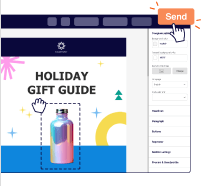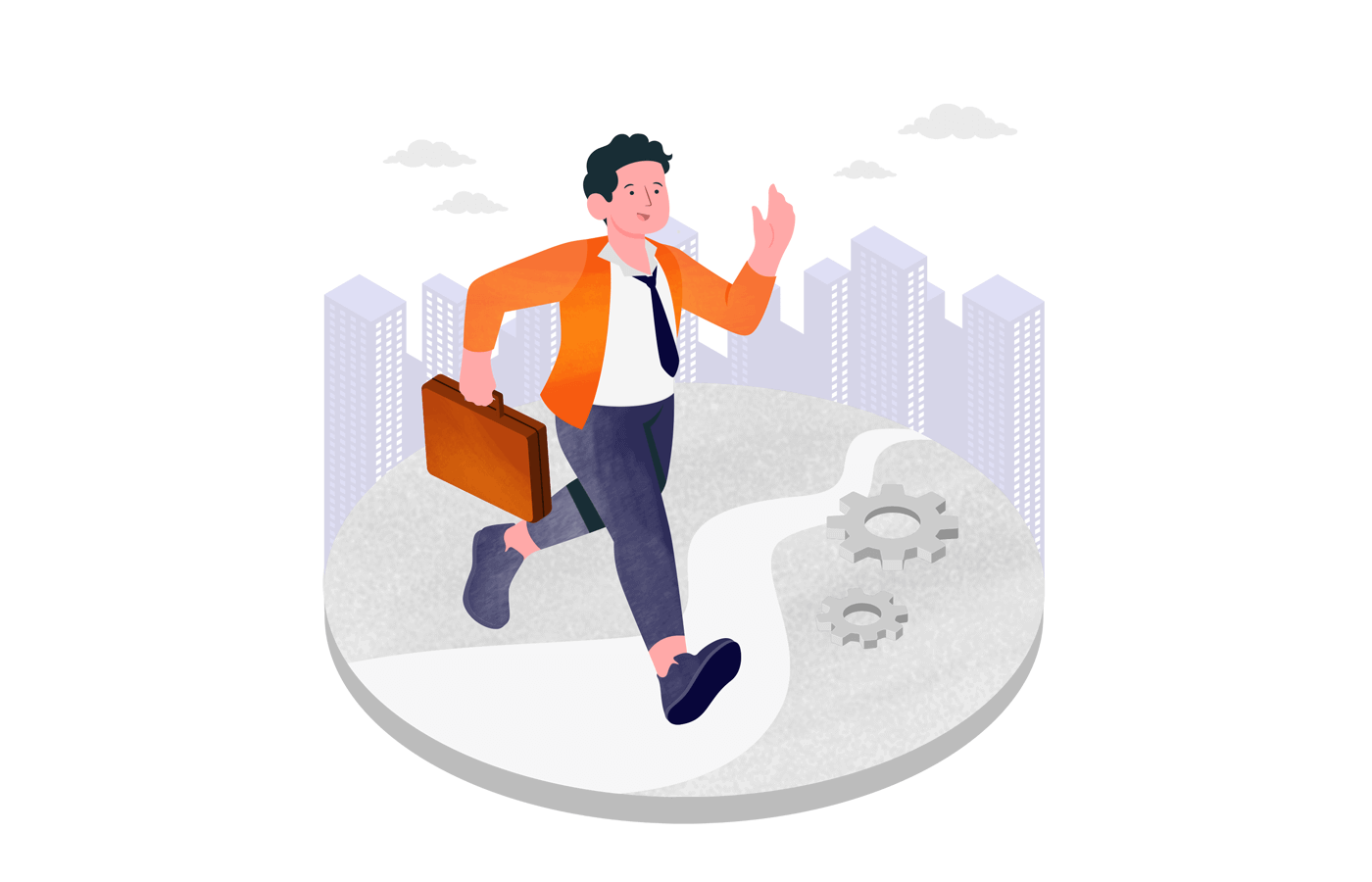As the world of ecommerce becomes more competitive and B2B buyers crave a personal touch, it’s no wonder many businesses are feeling stuck.
Don’t just take our word for it, let the numbers speak for themselves. 77% of B2B buyers claim that their latest buying experience was complex and did not match their expectations.
But fear not! The B2B ecommerce customer journey can be your guiding light, leading your clients towards making a purchase and minimizing possible frictions on the way.
Read on to learn how to create a B2B customer journey map that not only makes your customers happy but also keeps them coming back for more.
What is a B2B Ecommerce Customer Journey?
The B2B ecommerce customer journey is basically the whole experience that business buyers have when they make online transactions with suppliers or vendors.
It’s not like buying stuff for yourself — it’s way more complicated. There are a lot of steps involved, like finding the right supplier, doing research, and getting approval from a bunch of people.
The buying process has several B2B customer journey touchpoints, starting from comparing various options and ending with post-purchase support. The cool thing is that each step is a chance to make customers happy. So, how to make it happen?
For a start, make sure your website is easy to find on search engines, provides personalized content, and ensures a smooth checkout process. This can greatly improve customer satisfaction and help you build lasting relationships.
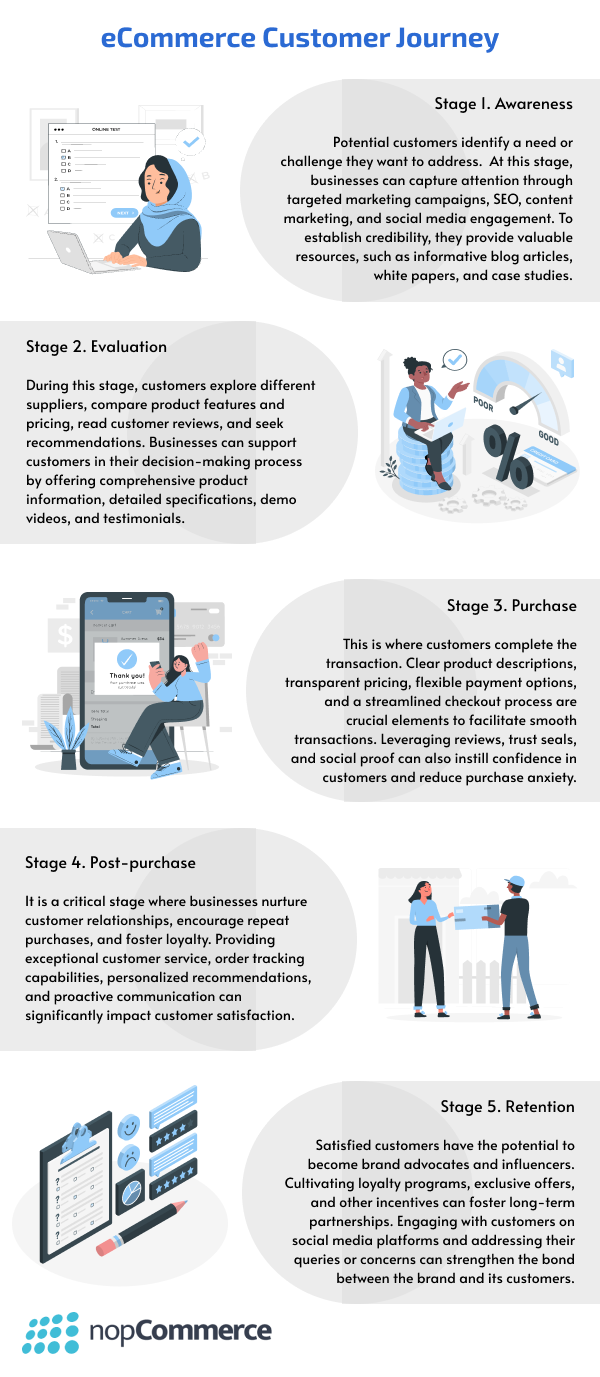
As you can see, it’s super important to understand different B2B customer journey stages. Plus, it’s crucial to know the difference between B2B and B2C so you can create strategies that meet the unique needs and expectations of your target audience.
How Does it Differ From B2C?
While B2C (business-to-consumer) and B2B (business-to-business) ecommerce share some similarities, there are notable differences between these two models:
- Decision-making complexity: In B2C ecommerce, the buying process is usually quick and straightforward. However, B2B ecommerce involves multiple people and takes longer.
- Relationship building: B2C transactions are often one-time and focus on creating positive experiences. In B2B ecommerce, the relationship between the buyer and the seller tends to be more ongoing and long-term.
- Personalization: B2C customers expect personalized product recommendations and targeted marketing campaigns. B2B customers want solutions that meet their business needs, like customized products, pricing and services.
- Content and information: B2C customers want to know about the product, what other customers think about it, and how much it costs before they buy it. B2B buyers need more technical information like compatibility and volume pricing, as well as contract details.
- Customer support: B2C customers may require assistance with order tracking, returns, or basic inquiries. B2B customers look for more extensive support, including dedicated account management, technical support, and ongoing training.
There are different types of B2B ecommerce, such as wholesale ecommerce, manufacturer ecommerce, B2B2C ecommerce, distributor ecommerce, etc. but the basic idea behind them all is pretty much the same.
Why is the B2B Ecommerce Journey Important?
Knowing the routine your customers go through before placing an order is extremely helpful for revealing existing problems and potential growth points.
Here are a few benefits and opportunities you can unlock if you build a custom B2B ecommerce journey:
- Better customer experience: This usually implies a user-friendly interface, getting personalized recommendations for products, and making the buying process smooth and hassle-free.
- Growing customer satisfaction: When the needs of B2B buyers are met, they become happy customers. And guess what? Happy customers tend to come back for more and even spread the word about your brand.
- Competitive edge: Giving customers an awesome experience can totally make a business stand out from the crowd and win even more customers.
- Data-driven insights: Knowing what customers want and how they behave is super important for businesses. It helps them improve their marketing and make their products or services even better for the people they’re trying to reach.
- Efficient sales process: A well-structured B2B ecommerce journey can make selling and buying way easier, i.e., through automated tasks.
- Cost savings: By simplifying shopping processes, both buyers and sellers can save time and effort.
5 Types of B2B Customer Journey Maps
When it comes to the digital customer journey in B2B, you need to break it down into different stages or maps so you can get a better idea of what their customers need, what’s bugging them, and what’s driving them to buy.
Basically, mapping represents a blueprint that shows all the different points where your customers interact with your business. It should include the following components:
- A flowchart or other diagram that illustrates the customer journey;
- All touchpoints between a company or brand and its customers;
- Areas where the customer is likely to encounter difficulties or negative feelings (pain points);
- The divisions and individuals providing the customer experience at each touchpoint (i.e., customer service, technical support, HR, sales, and marketing);
- Connections between touchpoints;
- Customer emotions elicited and desired at each touchpoint;
- Importance ratings for each touchpoint;
- The effectiveness of a business or brand at each touchpoint.
Here are some of the most popular types of B2B customer journey maps you can adopt:
Current-State Journey Maps
A current-state journey map is like a snapshot of where we’re at right now. It’s super helpful when you’re trying to figure out what your customers are going through and get everyone on the same page about what needs to be improved.
Day-in-the-Life Journey Maps
A day-in-the-life map recreates a regular day for customers or users. It looks at everything the customer is up to, to find out where they’re struggling, which actually means there are chances to meet those needs that no one else has tapped into yet.
Future-State Journey Maps
Being the opposite of the current-state B2B customer journey example, a future-state map does not focus on what’s happening now but shows what customers will be thinking and how they’ll be feeling in the future.
These maps are must-haves when it comes to planning out new products and digital experiences.
Blueprint Journey Maps
This customer journey map is based on one of the maps above, expanded with all the people, processes, and technology needed to deliver the experience.
Blueprint journey maps give you a complete and detailed look at how customers experience your brand from start to finish.
Tactical Journey Maps
A tactical journey map zooms in on one specific touchpoint to see what the customer goes through at that stage. When you’re dealing with a really important (or super annoying) issue, it’s probably your best solution.
Plus, these maps are great for training teams who are in charge of a certain part of the customer journey. For example, the tactical approach is typical of B2B ecommerce for distributors when dealing with shipment troubles.
Each type of B2B marketing customer journey mapping offers unique insights and benefits, but businesses can’t just choose the most suitable approach — they need to adapt it to their unique needs. Below, you’ll find out how to do that.
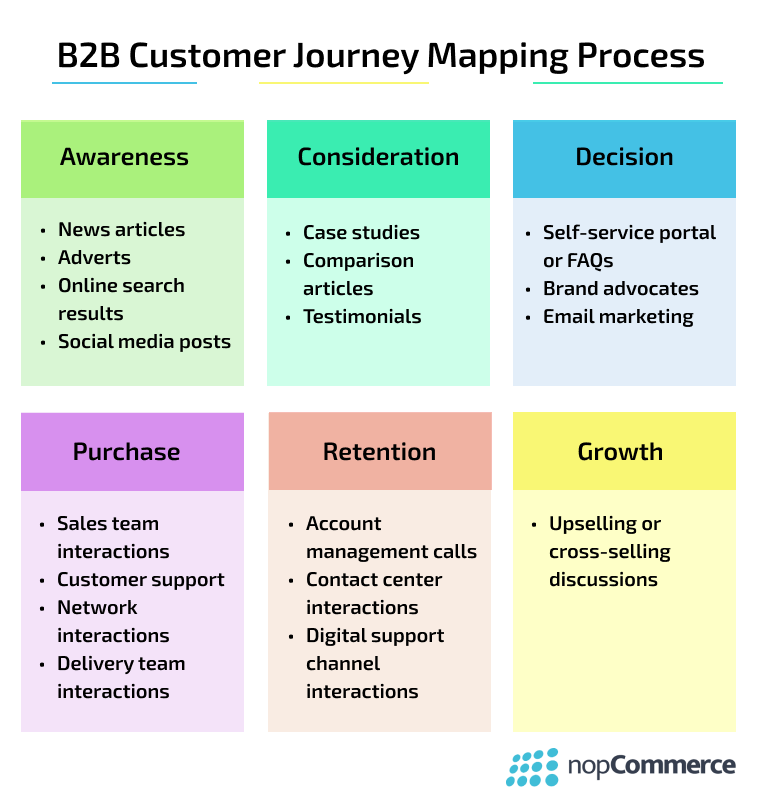
How to Improve the B2B Ecommerce Customer Journey?
If businesses decide to enhance their B2B ecommerce customer journey, there are a bunch of cool strategies they can use to make things easier and the experience more personal.
Utilize Marketing Automation
Automate boring tasks like sending personalized emails, taking care of leads, and delivering content to save time for something more important.
Customer segmentation based on industry, company size, purchasing history, or preferences will help you recommend products and set prices that fit each group’s needs.
Email marketing is one of the cheapest yet most effective ways to lead your prospects through the ecommerce customer journey. For hassle-free email campaign creation and automation, choose Sender:
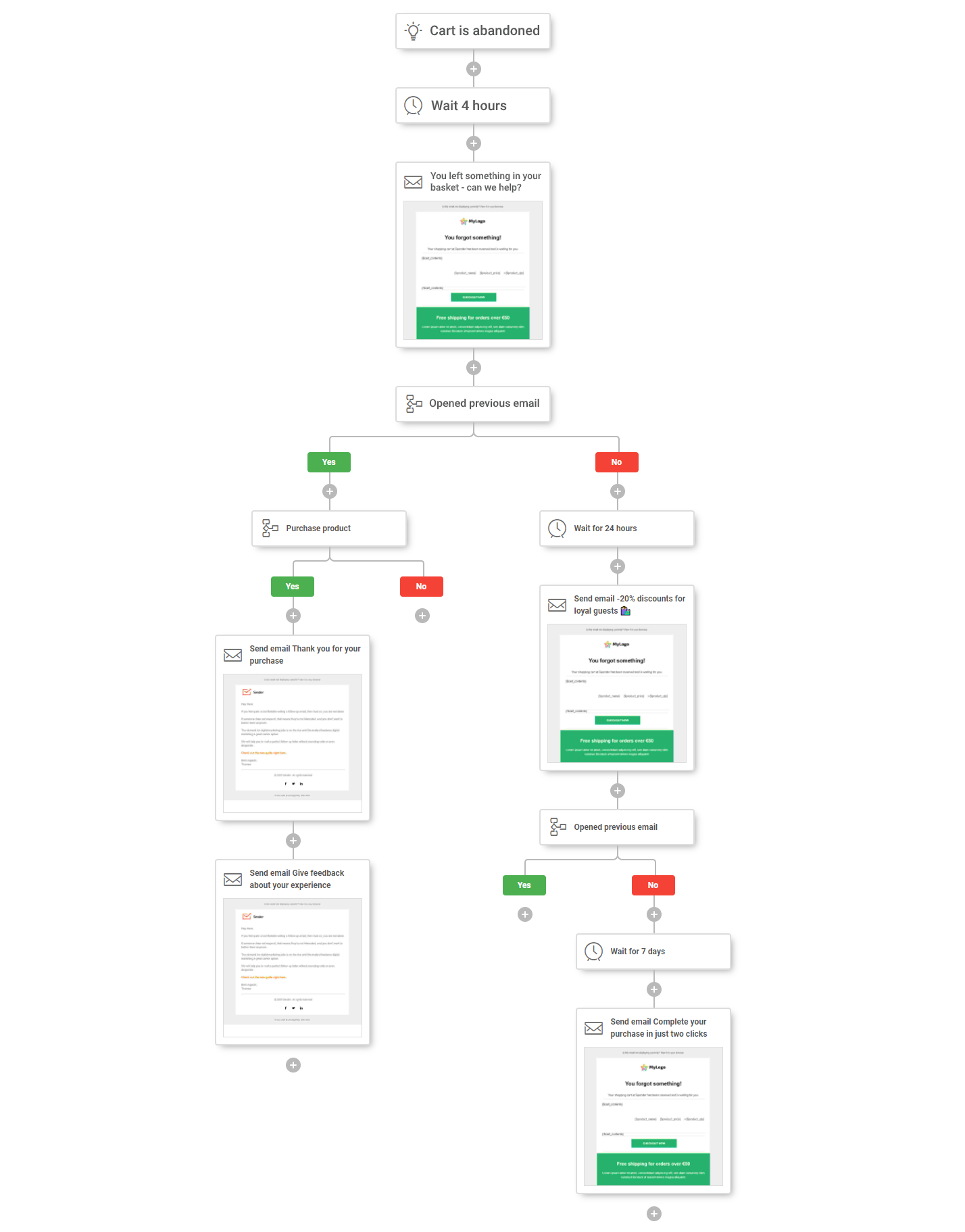
Offer Seamless Customer Support
Ensure your customers can easily get help when needed via a live chat, email, phone support, or dedicated support portal.
Offer helpful resources, like FAQs and a knowledge base, so that customers can find answers to their questions on their own.
Helping customers doesn’t stop after they complete their purchase. Keep assisting them by fixing any problems, teaching them how to use the product, and making sure they’re happy.
Data Collection and Analysis
Use surveys, customer feedback and feedback forms to gather valuable insights. Listen to your customers to find out what needs improvement and what trends are emerging.
Do A/B testing and try out different strategies and ways of doing things to see what works best. Figure out relevant KPIs to measure how well your customer support is doing. Set goals and keep track of how you’re doing over time.
Personalize the Experience
Personalization is key to making B2B buyers happy and loyal. Ensure your product descriptions, emails, and landing pages show them how your products or services can help them.
Use smart product recommendations to get them interested in new products and upsell them. Don’t forget to show them personalized pricing based on their order history and status.
B2B customers love a good deal, so consider offering discounts based on how much they buy or how long they’ve been with you. Keep it real, and they’ll keep coming back for more.
Streamline the Buying Process
Improving the B2B customer experience journey is all about making things easier. Reduce the hassle by creating a website that is easy to navigate, has a good search function, and a simple checkout process.
Add features like guest checkout, auto-fill forms, and address validation to speed things up. Offer different payment options by integrating with popular payment gateways.
It’s also important to give customers accurate and up-to-date information about inventory availability and pricing. This way, they can make informed decisions and won’t get frustrated by ordering things that are out of stock.
What Goes Into a Customer Journey Map?
When businesses gather information from different sources, they can get a complete picture of how customers interact with their products or services, what problems they face, and what drives them. This is what we call a customer journey map.
To make a customer journey map that actually works, there are a few important things to consider.
Customer Experience Optimization
CX optimization is at the core of a successful journey map. In this step, you gather data and feedback from various touchpoints to understand how customers interact with your brand.
Persona Development
Creating customer personas using demographic information, behaviors, and preferences is super helpful in making journey maps that reflect different types of customers.
Touchpoint Identification
All the different points where customers and brands connect should be identified and mapped. These touchpoints cover everything from visiting websites, sending emails, making support calls, and even chatting on social media.
Customer Emotions and Sentiments
Next, it’s time for emotional mapping to pinpoint the stuff that ticks off your customers and the stuff that makes them happy. That way, you can work on fixing the downsides and making your strengths even better.
Data Analysis
Collecting and studying data from customer interactions, surveys, and feedback helps companies understand their customer behavior. This data-driven approach allows them to recognize patterns and trends that affect the entire customer experience.
Identifying Pain Points and Opportunities
Finally, when you look at the data and feedback from customers, you can figure out where they’re getting annoyed or frustrated and focus on fixing those things first.
Action Planning
Action planning takes all the cool stuff you learned from the customer journey map and turns it into steps to improve the customer experience.
It’s got a few important parts, like:
Setting Clear Objectives
Set specific goals that match what you’ve learned from the journey map. These goals should be all about making the customer experience with your brand even better so they’ll be more satisfied, loyal, and excited to keep engaging with you.
Prioritization
Based on the identified pain points and opportunities, prioritize the areas that need immediate attention and improvement. Think about how it’s going to affect the customer experience and if it’s actually doable.
Cross-Functional Collaboration
To make sure customers have a great experience, all the teams need to work together. Get the marketing, sales, customer service, product development, and other teams involved in creating a customer journey map and making it better.
Designing Solutions
Once you figure out what’s bugging the customers, you gotta come up with solutions that totally focus on them. These solutions should tackle the different types of customers and the specific problems at every interaction point.
Implementation and Monitoring
Complete the action plan and keep an eye on how it’s affecting the customer experience. Keep checking important numbers and customer feedback to see if the improvements are working and if there’s anything else that can be done.
By following these simple steps, businesses can make customer journey maps that really make a difference in how their customers feel.
Conclusion: Connect, Convert, and Conquer
The B2B marketing customer journey is a goldmine for businesses that know how to build it.
If you wanna make a bank, you gotta recognize all the touchpoints, map out the journey, use CRM systems, and get along with the latest technologies.
By doing all that, you can create the B2B ecommerce customer journey that keeps people coming back for more, increases your sales, and helps you stay ahead of the game.
Also read:
- What is B2B Sales? Process, KPIs, Nurturing
- 10 New Customer Acquisition Strategies
- 7 Best Client & Customer Onboarding Software
- Email Marketing Customer Journey: Ultimate Guide for Conversion
Author bio
Olesya Zagorodnova is a Digital Marketing Manager at nopCommerce, an open-source ecommerce platform with built-in B2B functionality. With 8+ years of experience in internet marketing, she’s been working with both B2C and B2B products.
